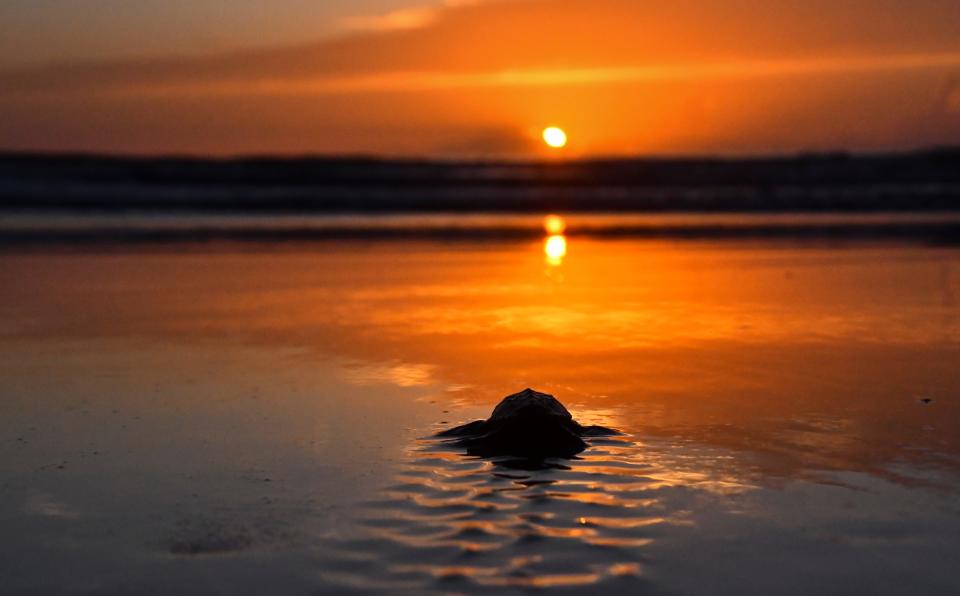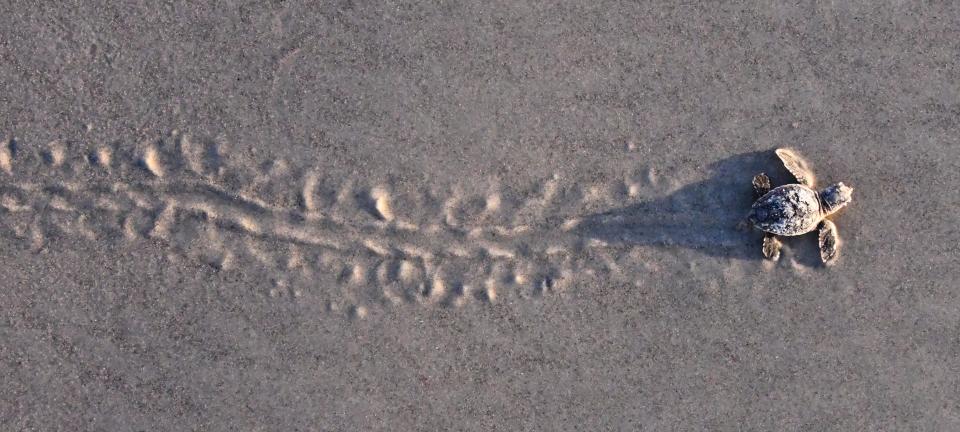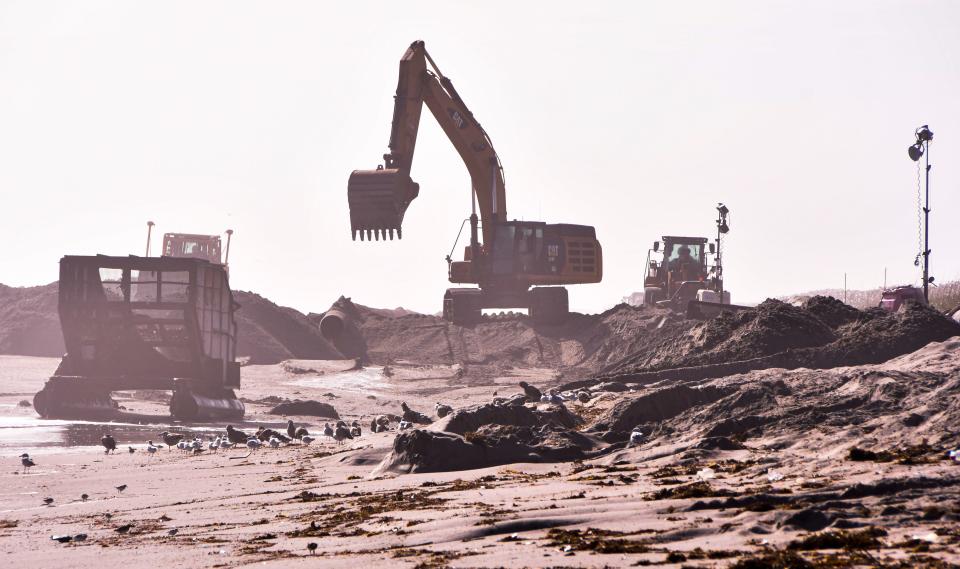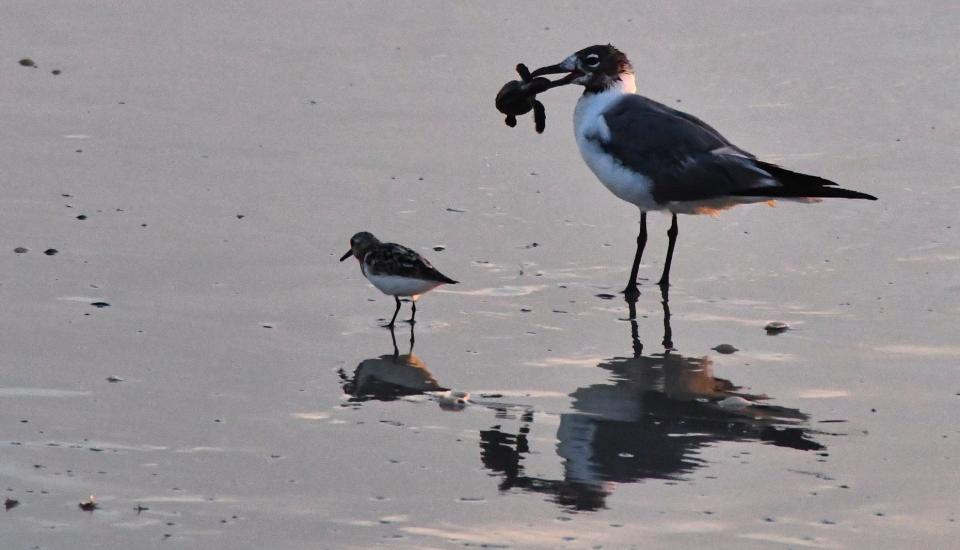Sea turtles hold strong this summer but danger beckons

As the sun rises on sea turtle nests across the Space Coast, biologists see new rays of hope.
Many feared for the future of Florida's three most prominent types of endangered sea turtles — greens, loggers and leatherbacks — but this year evidence suggests they are rebounding.
That's especially true along Brevard County's Space Coast, where astronauts launched to the moon and these prehistoric leviathans lay countless eggs.
"Yes, generally, we have had a good season for leatherbacks (a new record, though the numbers are still low given we are at the northern range of where leatherbacks nest along our coastline)," wrote Kate Mansfield, associate professor at University of Central Florida.
"Over the decades, green turtles have made an incredible come-back," she added, crediting conservation measures. "Loggerheads are generally holding strong."
But one year does not a trend make, Mansfield warned. "Sea turtle work is 'slow science' and we need decades of data before we can really assess population trends," she noted.
Many reasons for concern remain: these days sea turtles drop their eggs into holes of hotter sands, which means few-if-any males hatch and less genetic diversity, sending recent population rebounds into reptilian tail spins of uncertainty. As with alligators, the temperature of the incubating egg determines a sea turtle's gender.
"Generally speaking, it's certainly a worry that hotter and hotter summers will change the sex ratios of hatchlings originating from our beaches, producing more females," Mansfield said.
"There are a number of factors that play into the temperatures that the turtle eggs experience while incubating — depth of clutch, rainfall, sand color or time of year the nest incubates."
Stringy, smelly algae dominates coastline from Cocoa Beach to Sebastian and beyond
Research in South Florida has found that in hotter beach sand of recent summers almost all sea turtle hatchlings are female. Scientists suspect similar, less extreme shifts in gender ratios along Space Coast beaches but lack data to prove .
There are other problems, too.
Warmer summers also mean increasingly thicker seaweed for the hatching turtles to navigate to reach the Gulf Stream, where seaweed is less an obstacle and more a vital food source and place to duck predators.
Seaweed isn't the only thing turtles dodge. They also have to avoid beachside furniture, fishing nets and some perish from swallowing floating tar or plastic.
Green sea turtles defying odds
Paddling out against those ever-strengthening currents of challenges, only the fittest survive. Of every one hatched, estimates range one in 1,000 to one in 10,000 survive long enough to become an adult turtle.
But the good news is that one species in particular has defied the odds.
'Old school' naturalist, sea turtle 'legend' leaves legacy of refuge and 'new school' naturalists
What's that dark sand on beach? It's not dirt
In the 1970s, biologists could only find a handful of green sea turtles nests at Archie Carr National Wildlife Refuge and the Melbourne Beach area, both in Brevard County. Many biologists thought greens would soon go extinct, but decades of conservation measures paid off.
Pressure from commercial fishing, diseases and habitat loss chipped away at the reptile's numbers. Hatchlings wander onto roads because of bright beach lights. In nations where their sweet-tasting meat is savored by the locals, the perils are worse.
But green sea turtle nest counts on key index beaches, which include more than a dozen miles of shoreline in Brevard, have increased eightyfold since standardized nest counts began in 1989, according to the Florida Fish and Wildlife Conservation Commission.
Greens are just one of three species that use the Carr refuge as their main nesting grounds. Endangered leatherback and threatened loggerhead sea turtles also nest on Brevard's beaches and have shown promising long-term trends, although fluctuations in recent years.

Loggerheads are the most plentiful sea turtle species that nests in Florida. By 2012, loggerhead sea turtle nesting hit a near 24-year high along Florida beaches, according to state biologists, doubling how many nests the reptile dug just five years prior.
Hot sands impact turtle hatchlings
But loggers and other sea turtles face darker, hotter times ahead, wildlife biologists warn, driven by global warming.

Darker sand absorbs more heat from the sun, creating changes in turtle eggs that result in more females. If beach sand is too white, then there is more reflection and cooler sands meaning the number of males increases.
Sand 82 degrees Fahrenheit or warmer tends to render a female. Below that temperature, males become more likely. No one knows exactly why. The theory is that a mix of hormones send chemical cues, triggered by beach sand temperature, that turn certain genes on but switch others off. A sea turtle's gender is determined about 40 days into its incubation period, which averages about 60 days.
Enter dredges and trucks that put countless cubic yards of sand on Florida's beaches after every big storm.
Biologists worry that if renourished beach sand is too light or dark, it might bend the turtle gender ratio out of whack, threatening the long-term survival of the species. Too few of either sex could thwart reproduction and genetic diversity. A smaller mating pool for turtles means less resilience and higher risk of birth defects and disease.

A 2008 study by Florida Atlantic University found that up to two males for every five female loggerheads hatch on Florida sands, considered a healthy ratio for the threatened species.
The overnight darkening of sand color on Brevard beach renourishment projects has at times made local residents see red.
The new sand pumped to Brevard's beaches comes from an area about five miles off Cape Canaveral, called Canaveral Shoals.
The county's contractors test the sand daily to make sure it's the proper grain size and color and has the appropriate carbonate content. The sand appears darker because it's been on the ocean floor for years and not lightened by the sun, but biologists say sea turtles have evolved and adapted to the range of sand colors here.
Sargassum seaweed: too much of a good thing?
Sea turtles also have to contend with this summer's thicker-than-usual Sargassum seaweed. The Caribbean Sea delivers the seaweed seasonally to the Gulf Stream and then Central Florida's beaches.
Oceanographers expect Sargassum seaweed and other macroalgae to thicken on our beaches every year, as a result of more coastal runoff and warmer waters, driven by climate change.
"Sargassum in the surf zone is actually a bit more of a threat to at least the hatchlings when it's washing ashore," Mansfield said.
Hatchlings are "hard-wired" to swim offshore to where they remain for at least a few years.
"But, that first push to get offshore is critical," Mansfield added. "If they encounter obstacles, like piles of Sargassum, that means they have to spend more of that precious energy that should be put towards swimming -- and getting offshore, away from coastal predators."
It's especially daunting for hatchlings that are half the size of a deck of cards, Mansfield said.
"So, even a pile of Sargassum that is a foot high would be like us trying to scale a two-to-three-story building. Plus, there is risk of the hatchlings getting stuck," she said.
But biologists such as Mansfield keep witnessing and documenting a species that's poised to keep the sun from setting on its kind, especially the mothers.
"For the larger turtles, it's less of an issue as the nesting females can generally plow through, assuming that it's not an enormous amount," she said.
Turn off your beach lights
Beachside homes and businesses must turn off or shade their lights during sea turtle nesting season, which runs from Sea turtle nesting season officially begins March 1 for the Atlantic coast of Florida. Brevard County has a "lights-out" ordinance effective May 1 to Oct. 31 that requires all lights visible from the beach to be either covered, blocked, moved, or turned off from 9 p.m. to 5 a.m. This includes flashlights, cellphones, and red lights. Although sea turtles are less affected by red light, they do still see it.

Source: https://seaturtlespacecoast.org/
Jim Waymer is an environment reporter at FLORIDA TODAY. Contact Waymer at 321-261-5903 or jwaymer@floridatoday.com. Or find him on Twitter: @JWayEnviro or on Facebook: www.facebook.com/jim.waymer
Support local journalism and local journalists like me. Visit floridatoday.com/subscribe
This article originally appeared on Florida Today: Sea turtles nest on weedier, hotter Florida sands and what that means

